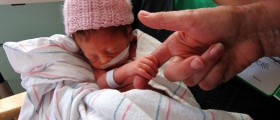
Down syndrome, also known as trisomy 21, is a serious genetic disorder associated with developmental disabilities, mental retardation and many health problems. All the problems children and people suffering from Down syndrome face with stem from an extra chromosome 21. The syndrome occurs in 1 out of 700 babies and it affects more babies of mothers who are older than 35 years of age.
Down Syndrome - at Birth
Even though many cases of Down syndrome can be successfully diagnosed while the baby is still in the uterus thanks to prenatal screening and specific tests, many children are diagnosed with the syndrome once they are born.
A well experienced pediatrician can instantly recognize clinical characteristics of Down syndrome and diagnose the condition. Namely, such children have poor muscle tone, a small head and flat nasal bridge. Furthermore, there are upward slanting eyes, palpebral fissures and epicanthal folds. Both ears and mouth are small. The fifth finger is shorter comparing to others, turned inward, and there is a characteristic crease in the middle of the palm. Finally, these children have excess skin fold at the nape of the neck, large tongue and a large space between the fourth and fifth toes.
Down Syndrome - the Infancy
Developmental and health problems which typically affect these children in the newborn period are feeding difficulties and associated poor growth. The development is even more impaired if a child is suffering from a heart condition. In order to overcome such issues, babies are fed high calorie formula. During regular check-ups the doctor assesses the growth and development and may search for additional abnormalities. At this time parents may seek a support group and search for a well experienced occupational and physical therapist.
During the first year of a baby's life doctors pay close attention to the thyroid gland, potential hearing loss and eye abnormalities. Further attention remains localized on feeding.
Down Syndrome - the Early Childhood
Between 1 and 5 years of age the child is still thoroughly monitored regarding his/her growth and development. At this time doctors additionally pay attention to patient's spine and potential instability or subluxation. This is also the period when children undergo regular dentist exams because of dental abnormalities.
Down Syndrome - the Late Childhood
In children between the age of 5 and 13 as well as those who have entered adolescence (13-21 years of age) doctors keep on paying close attention to development in general. The thyroid gland function, vision as well as hearing abnormalities continue to be evaluated. Furthermore, doctors also assess learning and behavioral problems. At this time parents may discuss vocational planning and sign in their children in a group home or workshop.

















Your thoughts on this
Loading...